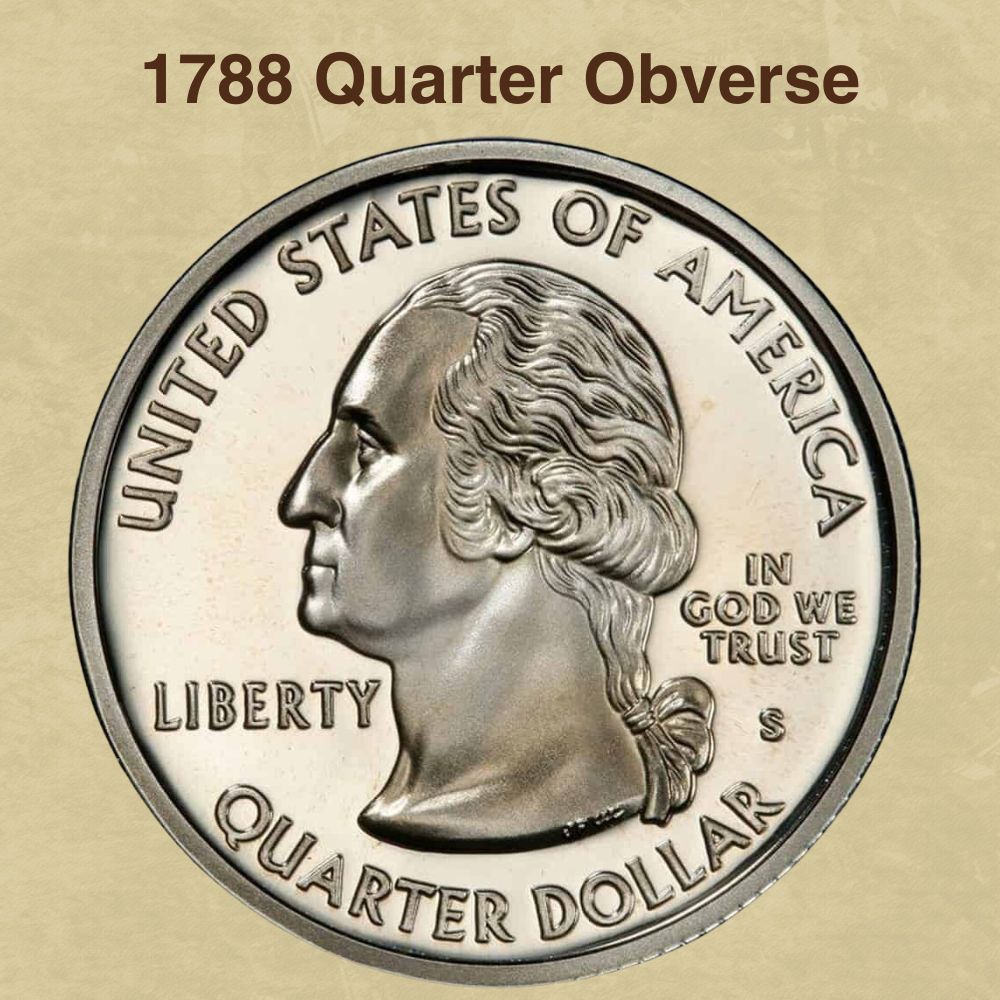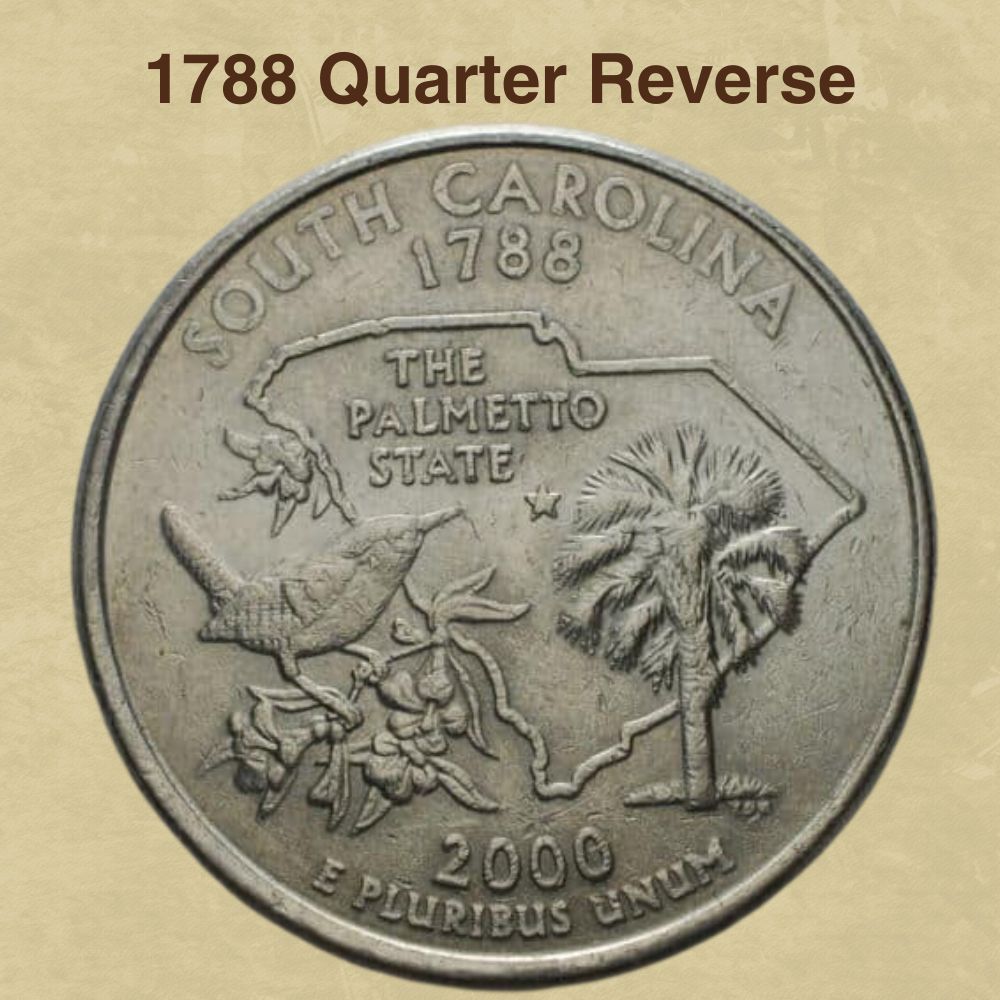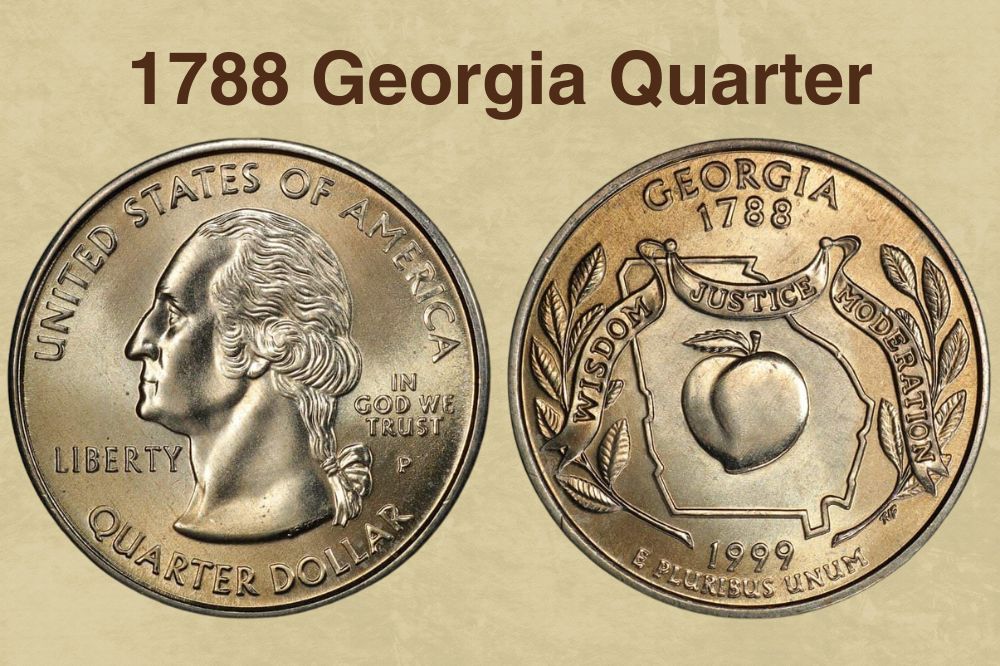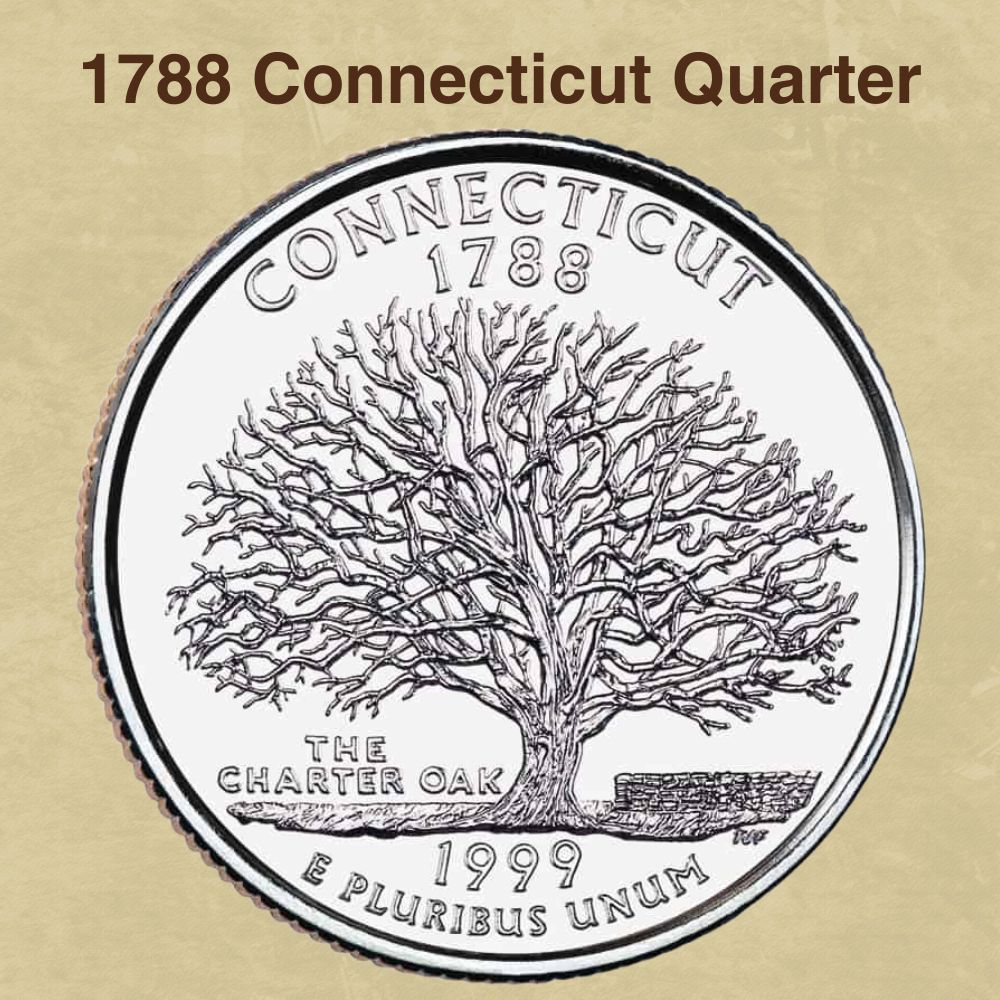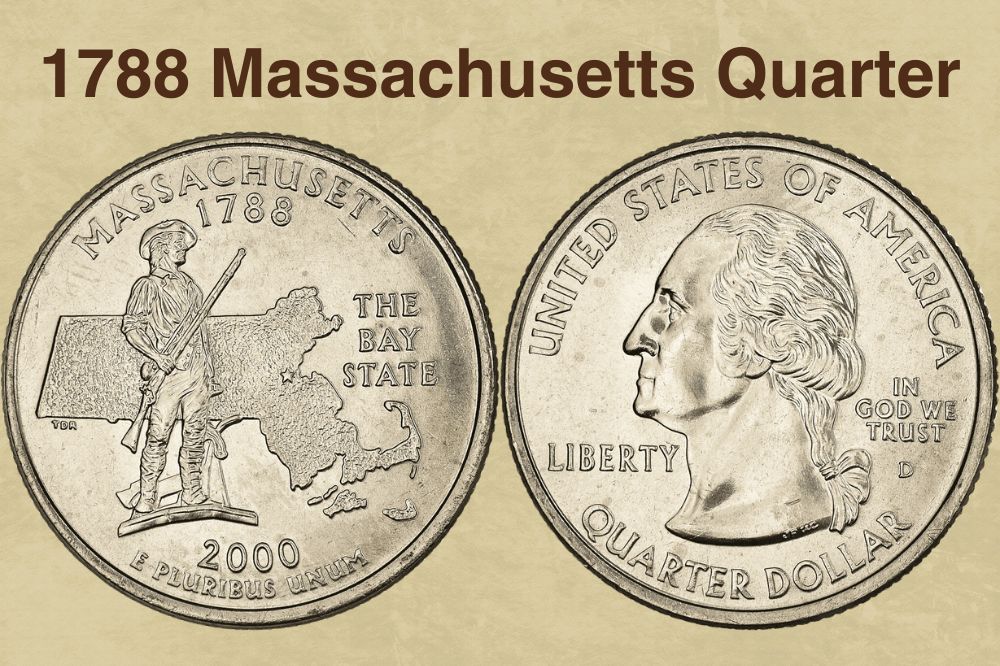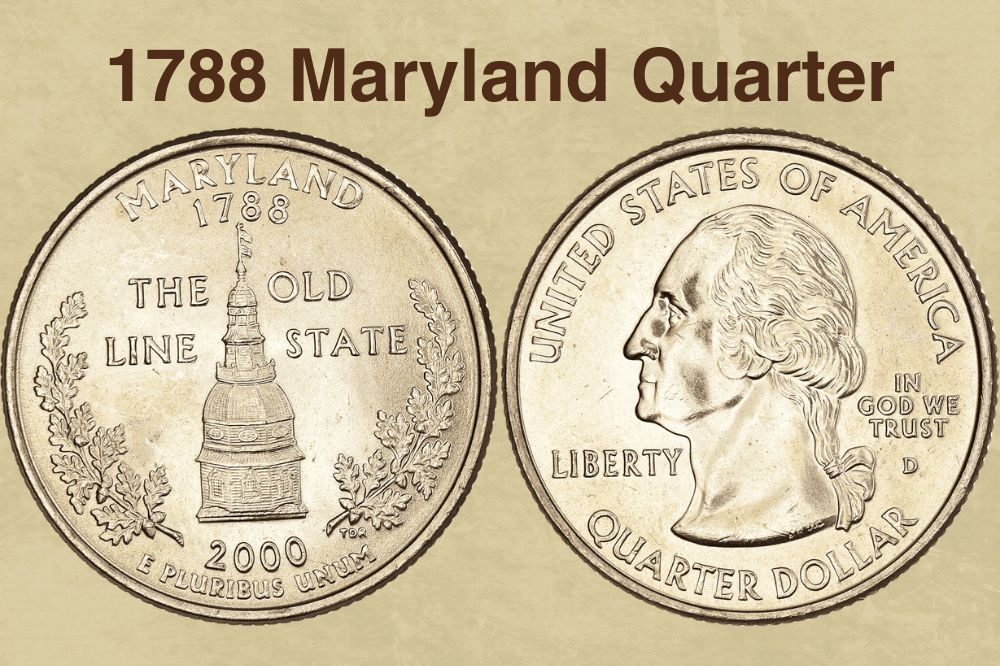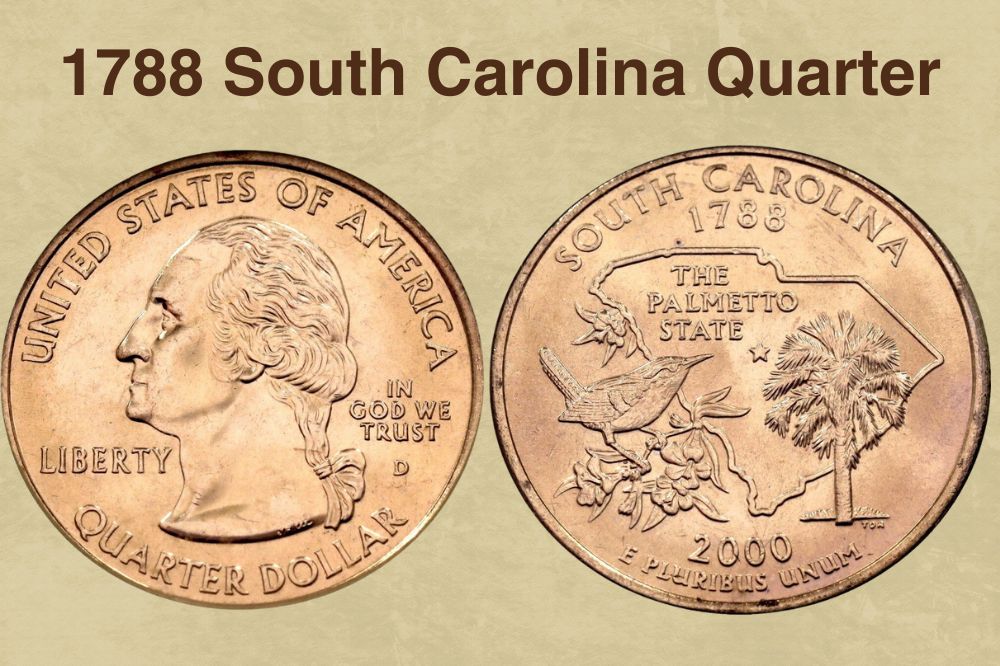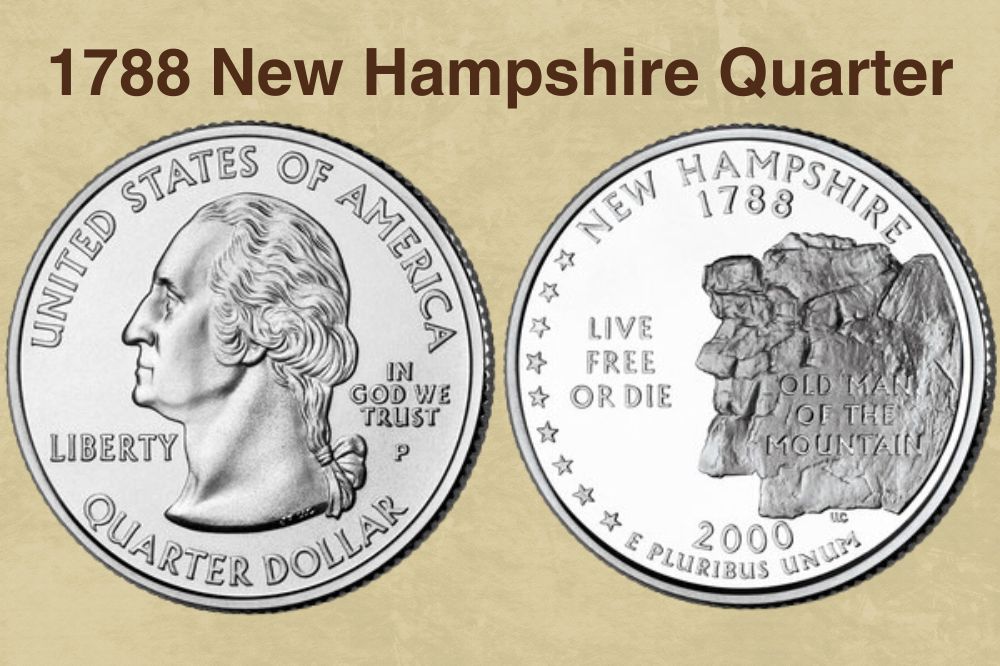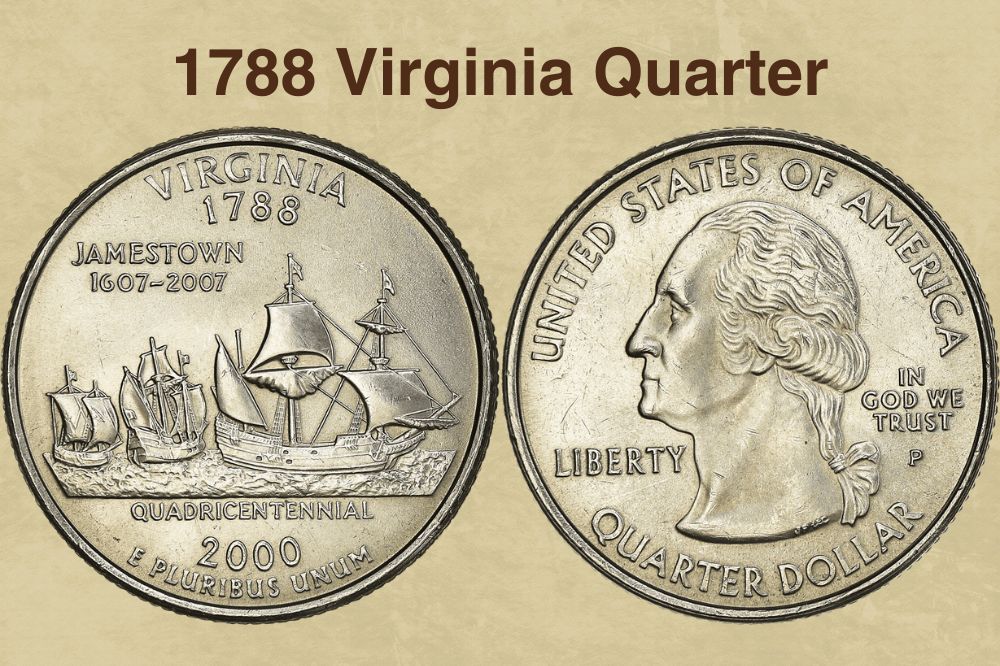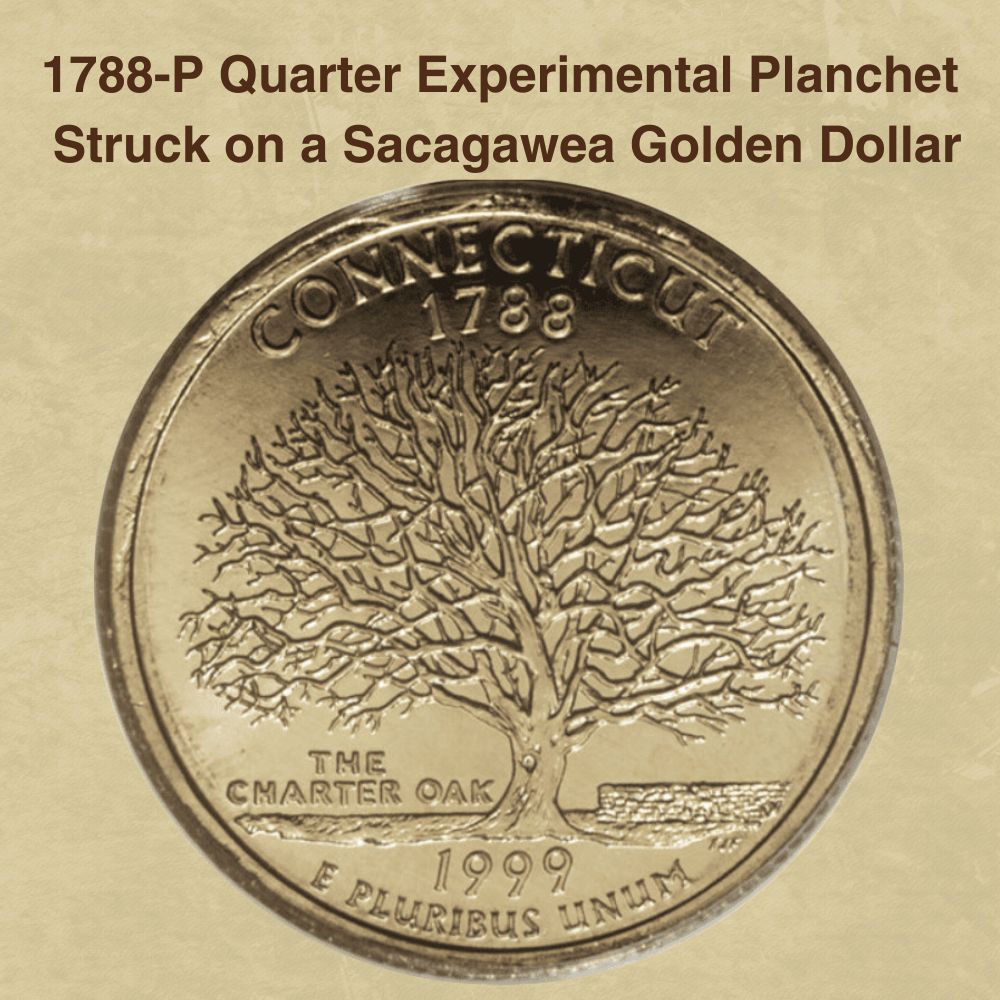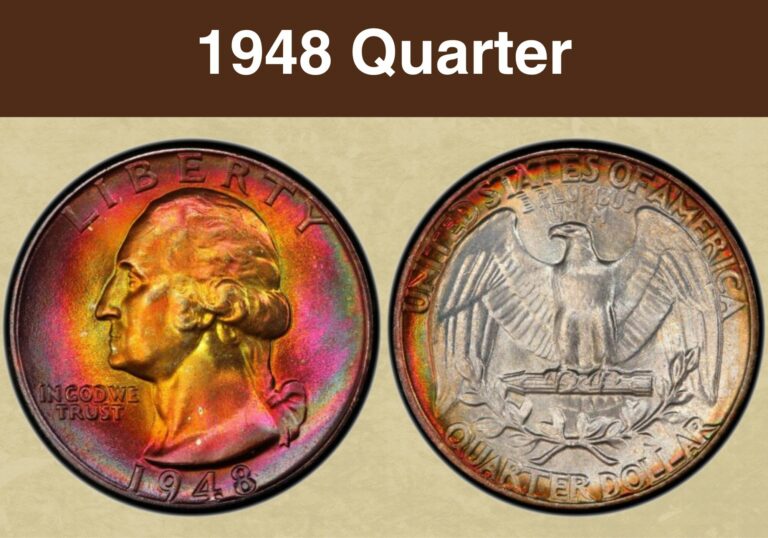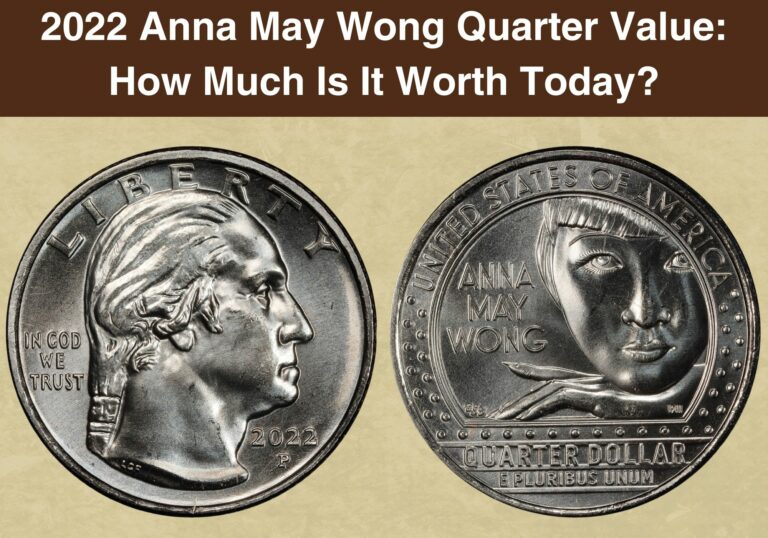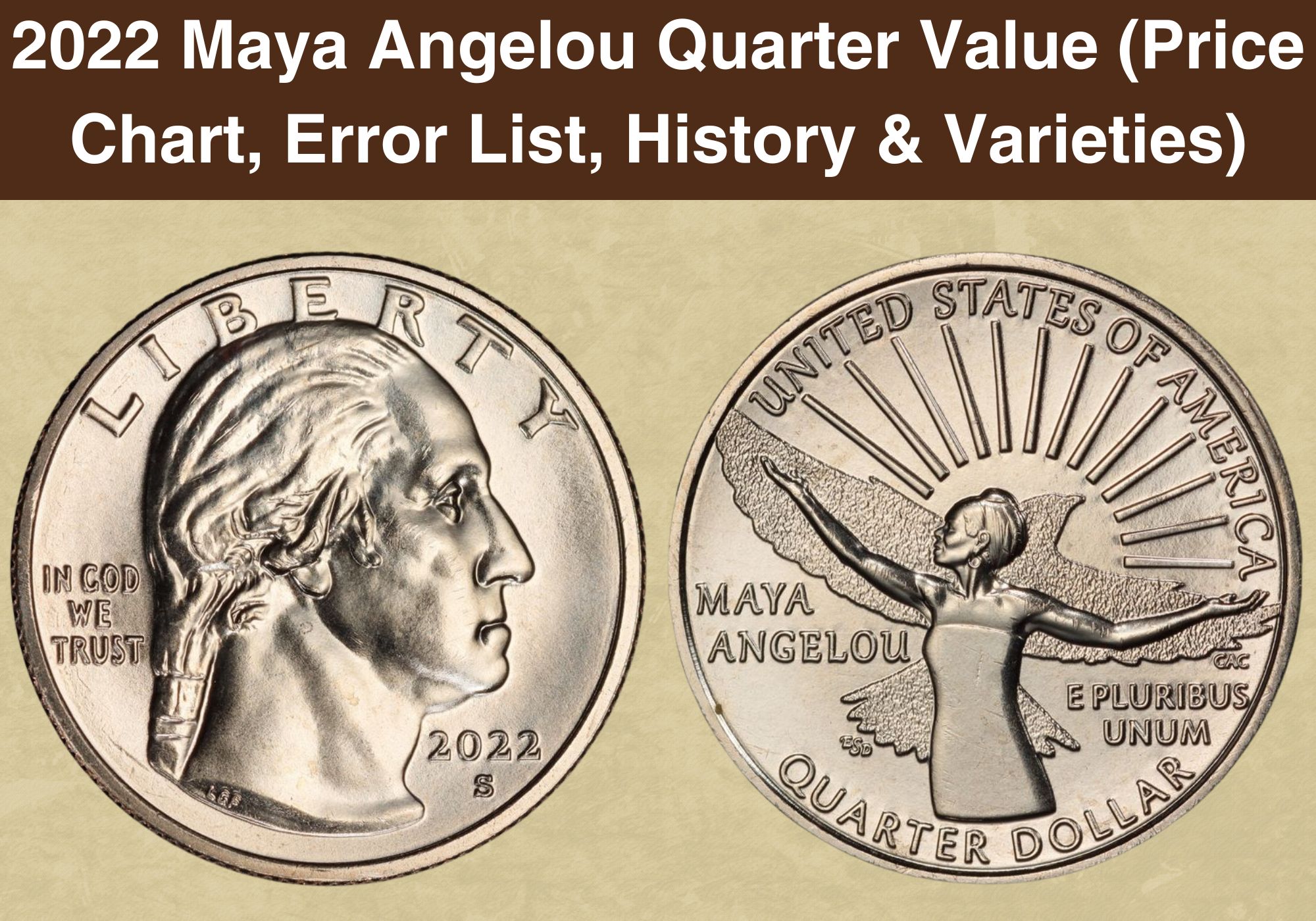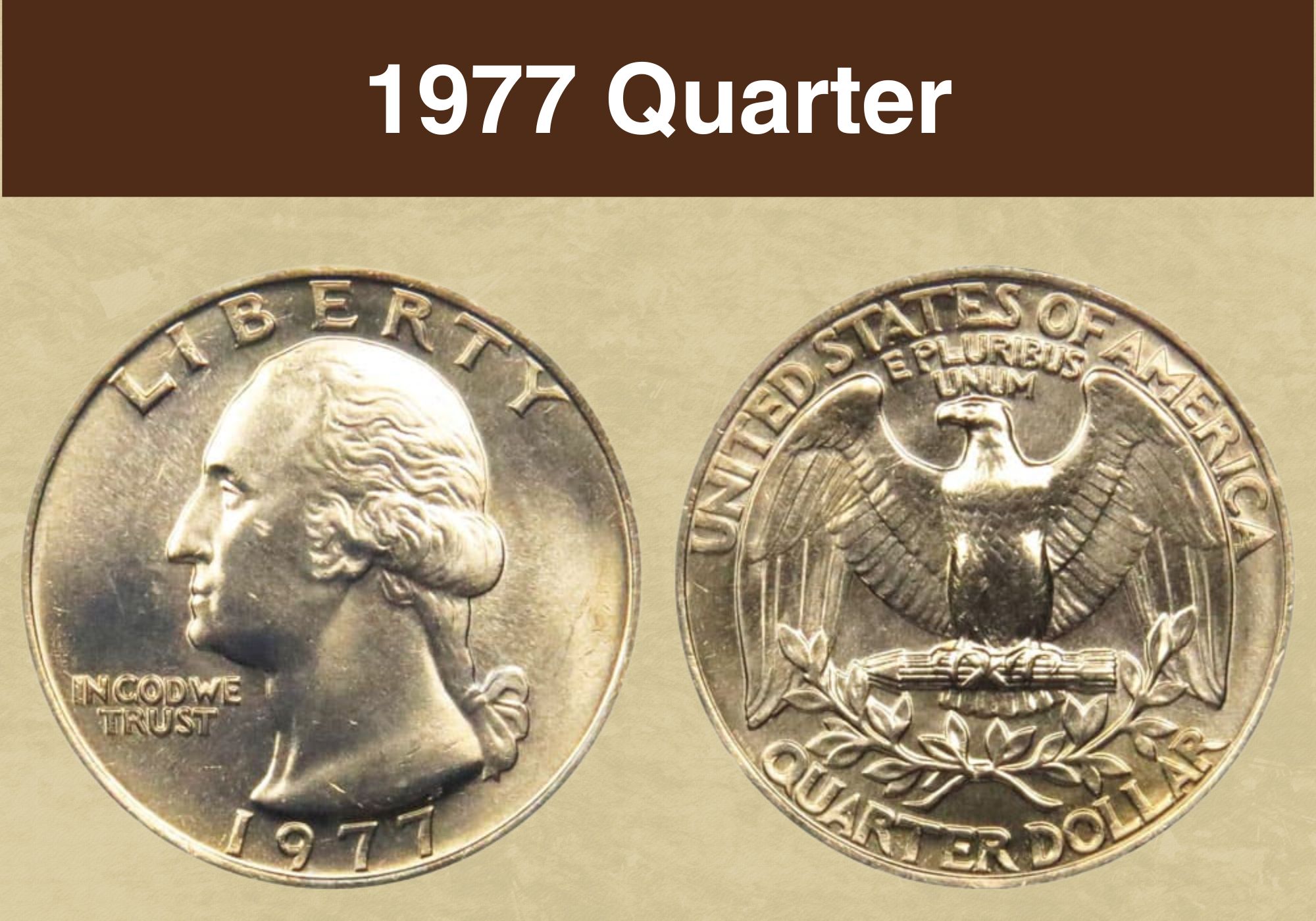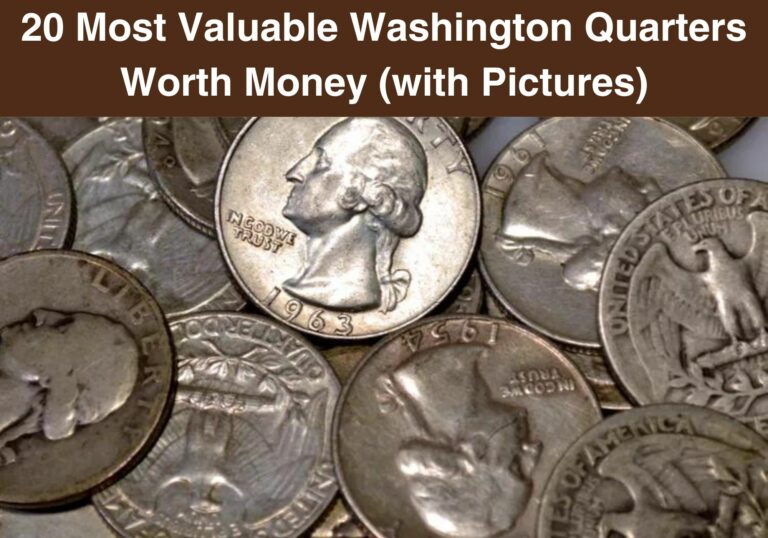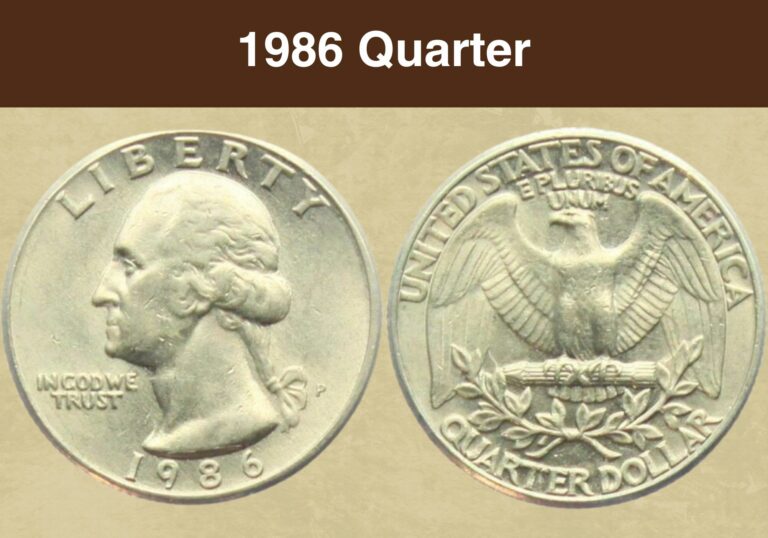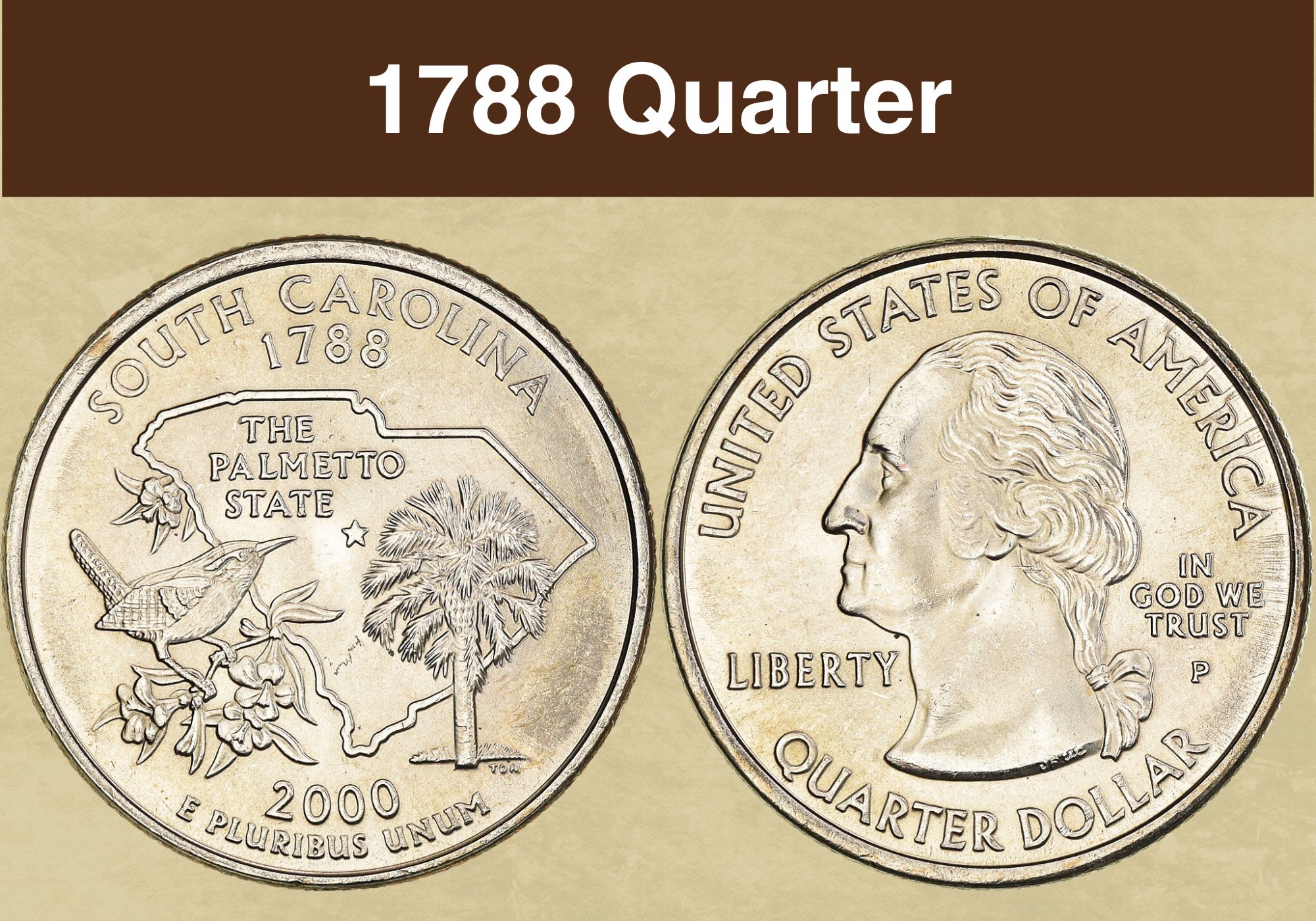
Coin Value Contents Table
- 1788 Quarter Value Chart – Circulating Coins
- 1788 Quarter Value Chart – Proof Coins
- History of the 1788 Quarter
- Features of the 1788 Quarter
- 1788 Quarter Grading
- 1788 Quarter Value Guides
- 1788 Georgia Quarter Value
- 1788 Connecticut Quarter Value
- 1788 Massachusetts Quarter Value
- 1788 Maryland Quarter Value
- 1788 South Carolina Quarter Value
- 1788 New Hampshire Quarter Value
- 1788 Virginia Quarter Value
- 1788 New York Quarter Value
- Rare 1788 Quarter Errors List
- Where to Sell Your 1788 Quarter ?
- 1788 Quarter FAQ
The US Mint opened its first branch in 1792. Before that, we used foreign coins from Spain, France, the UK, and colonial Europe. So how do you explain the 1788 Quarter? Well, it’s part of the 50 States Quarters series and covers the 8 states that joined the US Union in 1788. The coins themselves were minted in 1999 and 2001. Let’s learn about the 1788 Quarter Value.
1788 Quarter Value Chart – Circulating Coins |
||||||
| Coin | Mint Date | Mintage Figures | MS 65 | MS 66+ | MS 68 | MS 69 |
| 1788-P Georgia Quarter | 1999 | 451,188,000 | $5 | $26 | $5,500 | – |
| 1788-D Georgia Quarter | 1999 | 488,744,000 | $5 | $37 | $6,250 | – |
| 1788-P Connecticut Quarter | 1999 | 688,744,000 | $5 | $14 | $875 | $10,500 |
| 1788-D Connecticut Quarter | 1999 | 657,880,000 | $5 | $28 | $1,000 | – |
| 1788-P Massachusetts Quarter | 2000 | 628,600,000 | $5 | $14 | $60 | $7,000 |
| 1788-D Massachusetts Quarter | 2000 | 535,184,000 | $5 | $14 | $325 | $9,000 |
| 1788-P Maryland Quarter | 2000 | 678,200,000 | $5 | $12 | $160 | – |
| 1788-D Maryland Quarter | 2000 | 556,532,000 | $5 | $14 | $275 | – |
| 1788-P South Carolina Quarter | 2000 | 373,400,000 | $5 | $14 | $50 | $8,000 |
| 1788-D South Carolina Quarter | 2000 | 401,424,000 | $5 | $14 | $110 | – |
| 1788-P New Hampshire Quarter | 2000 | 673,040,000 | $5 | $12 | $160 | – |
| 1788-D New Hampshire Quarter | 2000 | 495,976,000 | $5 | $14 | $400 | – |
| 1788-P Virginia Quarter | 2000 | 943,000,000 | $5 | $14 | $150 | – |
| 1788-D Virginia Quarter | 2000 | 651,616,000 | $5 | $16 | $750 | – |
| 1788-P New York Quarter | 2001 | 619,640,000 | $5 | $14 | $38 | $975 |
| 1788-D New York Quarter | 2001 | 655,400,000 | $5 | $18 | $1,050 | – |
1788 Quarter Value Chart – Proof Coins |
||||||
| Coin | Mint Date | Mintage Figures | PR 66+ DCAM | PR 68+ DCAM | PR 69 DCAM | PR 70 DCAM |
| 1788-S Clad Proof Georgia Quarter | 1999 | 3,713,359 | $8 | $8 | $8 | $26 |
| 1788-S Silver Proof Georgia Quarter | 1999 | 804,565 | $8 | $10 | $18 | $60 |
| 1788-S Clad Proof Connecticut Quarter | 1999 | 3,713,359 | $8 | $8 | $20 | $27 |
| 1788-S Silver Proof Connecticut Quarter | 1999 | 804,565 | $12 | $12 | $20 | $55 |
| 1788-S Clad Proof Massachusetts Quarter | 2000 | 4,020,172 | $8 | $8 | $19 | $30 |
| 1788-S Silver Proof Massachusetts Quarter | 2000 | 965,421 | $10 | $14 | $22 | $70 |
| 1788-S Clad Proof Maryland Quarter | 2000 | 4,020,172 | $8 | $8 | $21 | $32 |
| 1788-S Silver Proof Maryland Quarter | 2000 | 965,421 | $10 | $14 | $22 | $55 |
| 1788-S Clad Proof South Carolina Quarter | 2000 | 4,020,172 | $8 | $8 | $18 | $35 |
| 1788-S Silver Proof South Carolina Quarter | 2000 | 965,421 | $10 | $14 | $22 | $60 |
| 1788-S Clad Proof New Hampshire Quarter | 2000 | 4,020,172 | $8 | $8 | $19 | $35 |
| 1788-S Silver Proof New Hampshire Quarter | 2000 | 965,421 | $10 | $14 | $22 | $170 |
| 1788-S Clad Proof Virginia Quarter | 2000 | 4,020,172 | $8 | $8 | $19 | $30 |
| 1788-S Silver Proof Virginia Quarter | 2000 | 965,421 | $10 | $14 | $22 | $65 |
| 1788-S Clad Proof New York Quarter | 2001 | 3,094,140 | $8 | $8 | $19 | $35 |
| 1788-S Silver Proof New York Quarter | 2001 | 889,697 | $10 | $14 | $22 | $55 |
History of the 1788 Quarter
Coin collecting is a popular hobby among certain demographics. And it earns the US Mint a lot of revenue. But while younger people may inherit heirlooms from aging relatives, the mint wants to encourage interest in newer coins as well. That way, the mint can generate extra cash by selling coins directly to these budding numismatists. But how are they lured in?
One way is through commemorative coin series. The first of these was the 50 States Quarters Program. It was launched in 1997 to produce a Quarter in honor of every US State. This was followed by the Washington DC and Territories Series. After that came the National Parks and Monuments Series, also known as America the Beautiful Set of 56.
The most recent series is the American Women Quarters, which will have 20 coins in total. Getting back to 50 States Quarters, the plan was to release five coins every year in the order they joined the Union. The states that ratified the constitution in 1788 are Georgia, Connecticut, Massachusetts, Maryland, South Carolina, New Hampshire, Virginia, and finally, New York.
As we said earlier, these eight states were represented on the Washington Quarters struck from July 1999 to January 2001. The coins also had iconic words and images that showed the spirit of each state. These were mostly designed through state-wide contests that were open to local sculptors and artists. US Mint staff would then engrave these concepts onto coins.
Also read: Top 13 Most Valuable State Quarters Worth Money
Features of the 1788 Quarter
Let’s go over some technical terms you may come across when describing the features of a coin. The heads side is the obverse, the tails side is the reverse, the thin side is the edge, and the raised border is the rim or collar. The images are devices, the words are called legends or mottos, and the backdrop is the field. Some edges have ridges called reeds. Others are plain.
The Obverse of the 1788 Quarter
It shows George Washington facing left. The legend United States of America is above his head, with Liberty next to his Adam’s Apple and In God We Trust behind his neck. The mint mark is under this national motto. The bottom of the coin says Quarter Dollar. The right side of his neckline cut-off has JF and WC for coin designers John Flanagan and William Cousins.
The Reverse of the 1788 Quarter
All 50 coins have a similar template though the devices themselves differ. Along the upper rim, you’ll find the name of the state followed by the year it joined the Union. Meanwhile, the lower rim displays the motto E Pluribus Unum with the mint date above it. The rest of the coin has various images, words, symbols, and designer initials based on that specific state.
Other Features of the 1788 Quarter
The 1788 Quarter has both clad and silver versions. Circulating coins have 91.67% copper and 8.33% nickel, comprising a pure copper core under clad layers of 75% copper and 25% nickel. But some proof coins are 90% silver and 10% copper. Both types are 24.26mm across and 1.75mm thick with 119 reeds. The clad coins weigh 5.67g while the silver ones are 6.25g.
1788 Quarter Grading
Quarters were originally silver coins, so even after they became clad in 1965, nickel was used to recreate that silver toning. These coins are graded on the Sheldon Scale from Poor (PO 1) to Mint State (MS 70). Some people use Mint State and Uncirculated interchangeably. For others, Uncirculated Coins are typically graded 50, 53, 55, and 58, especially within the UK.
| # | Grade |
|---|---|
| 1 | Basal State-1 |
| 2 | Fair |
| 3 | Very Fair |
| 4, 5, 6 | Good |
| 7, 8, 10 | Very Good |
| 12, 15 | Fine |
| 20, 30 | Very Fine |
| 40 | Extremely Fine |
| 50 | About Uncirculated |
| 60 | Mint State |
| 65 | Mint State |
| 70 | Mint State |
Please check our grading guides to know your coin scale, It’s the necessary step to know the exact value of your coin.
Check out now: How to Grade Washington Quarter?
1788 Quarter Value Guides
1788 Quarters can also be categorized as 1999 Quarters, 2000 Quarters, or 2001 Quarters depending on their state. Georgia and Connecticut coins came out in 2000 while New York coins are from 2001. The other five are 1999 Quarters. That makes a total of 32 varieties that include clad and silver proofs. Let’s confirm their values by variety, grade, and mint mark.
1788 Georgia Quarter Value
Georgia joined the Union on 2nd January 1788. The Mint made 939,932,000 Georgia Quarters, releasing the first batch on 19th July 1999. A 1788-P Georgia Quarter graded MS 65 was $4,200 in 2022. Meanwhile, a 1788-D Georgia Quarter graded MS 68 was $329 in 2013.
- Images: Two sprigs of the state tree (a live oak) flanking an outline of the state with a peach fruit in the middle.
- Words: Three banners showing the state motto: Wisdom, Justice, Moderation.
- Designer: TJF (under the stalk of the right oak branch) for T. James Ferell.
A 1788-S Clad Proof Georgia Quarter graded PR 70 DCAM sold for $1,150 in 2003. PCGS has nearly 1,000 and rates them at $26. Meanwhile, a 1788-S Silver Proof Georgia Quarter in PR 70 DCAM was $6,038 in 2007 but is $60 in April 2024. Over 1,200 have shown up so far.
1788 Connecticut Quarter Value
Connecticut joined the Union on 9th January 1788. They minted 1,346,624,000 Connecticut Quarters, releasing the first batch on 12th October 1999. A 1788-P Connecticut Quarter in MS 67 was $4,362 in 2006. One 1788-D Connecticut Quarter graded MS 68 was $2,300 in 2018.
- Images: The Charter Oak with the small brick hedge on its right.
- Words: The Charter Oak on the left side of the tree.
- Designer: TJF (under the brick wall) for T. James Ferell.
A 1788-S Clad Proof Connecticut Quarter in PR 70 DCAM was $1,035 in 2003. It’s now $27 with over 1,100 sent in. But a 1788-S Silver Proof Connecticut Quarter graded PR 70 DCAM was $1,610 in 2007. Over 1,000 samples are known so it’s only worth $55 in April 2024.
1788 Massachusetts Quarter Value
Massachusetts joined the Union on 6th February 1788. The 1,163,784,000 Massachusetts Quarters were made early in the year 2000, with the first batch released on 3rd January. A 1788-P Massachusetts in MS 69 was $3,760 in 2017. A 1788-D in MS 68 was $400 in 2018.
- Images: The Minute Man Statue with the state outline behind him.
- Words: The Bay State on the right of the state outline.
- Designer: TDR (under the left corner of the state outline) for Thomas D. Rodgers.
In 2013, the 1778-S Clad Proof Massachusetts Quarter wasn’t doing well. In PR 70 DCAM, it only fetched $300. Back in 2005, its 1788-S Silver Proof sibling graded PR 70 DCAM sold for $1,006. Today, PCGS has received more than 700 coins so their value in April 2024 is $70.
1788 Maryland Quarter Value
Maryland joined the US Union on 28th April 1788. The mint made 1,234,732,000 Maryland Quarters, releasing the first batch on 13th March 2000. A 1788-P Maryland Quarter graded MS 65 was $1,495 in 2005 while a 1788-D Maryland in MS 68 was $250 on eBay in 2011.
- Images: The Maryland State House Dome flanked by two clusters from the state tree, a White Oak.
- Words: The Old State Line flanking the spire of the dome.
- Designer: TDR (under the stalk of the right cluster) for Thomas D. Rodgers.
69 was not a lucky number for the 1788-S Clad Proof Maryland Quarter. It only got $207 in 2005, even in DCAM! And a 1788-S Silver Proof Maryland Quarter graded PR 70 DCAM was just $322 in 2007. Worse, with over 800 submitted, that has dropped to $55 in April 2024.
1788 South Carolina Quarter Value
South Carolina joined the Union on 23rd May 1788. The mint coined 1,308,784,000 South Carolina Quarters, releasing the first batch on 22nd May 2000. A 1788-P South Carolina in MS 69 was $3,525 in MS 69. A 1788-D South Carolina MS 63 Quarter was $2,990 in 2003.
- Images: The state bird (Carolina wren), the state flower (yellow jessamine), the state tree (cabbage palmetto), and the state outline with a star in the middle.
- Words: The Palmetto State inside the state outline, on its upper left side.
- Designer: TDR (under the tree on the right) for Thomas D. Rodgers.
In 2008, One 1788-S Clad Proof Quarter graded PR 70 DCAM sold for a mere $262. Today, it’s $35. Its silver counterpart, a 1788-S graded PR 70 DCAM sold for $1,035 in 2003. Since then, PCGS has received more than 700 pieces and estimates their April 2024 value at $60.
1788 New Hampshire Quarter Value
New Hampshire was the 9th State to join the Union, and it did so on 21st June 1788. The mint made 1,169,016,000 New Hampshire Quarters, releasing the first batch on 7th August 2000. A 1778-P New Hampshire in MS 64 was $2,128 in 2004. A 1778-D MS 68 was $633 in 2007.
- Images: The Old Man of the Mountain on the right with 9 Stars on the left.
- Words: The Old Man of the Mountain inside the mountain outline, and the state motto – Live Free or Die – on the left of the mountain.
- Designer: WC (under the mountain) for William Cousins.
In 2013, a 1788-S Clad Proof New Hampshire Quarter in PR 69 DCAM was $881. An eBay vendor sold a 1788-S Silver Proof New Hampshire Quarter graded PR 70 DCAM for $650 in 2021. PCGS disagrees with this evaluation, estimating the coin price at $170 in April 2024.
1788 Virginia Quarter Value
Virginia joined the US Union on 25th June 1788. They made 1,594,616,000 Virginia Quarters, releasing the first batch on 16th October 2000. A 1788-P Virginia Quarter graded MS 68 was $400 on eBay in 2022. But a 1788-D Virginia Quarter graded AU 55 sold for $1,610 in 2004.
- Images: The first ships to reach landfall in Virginia – Discovery, Godspeed, and Susan Constant.
- Words: Jamestown 1607-2007 on the upper right, Quadricentennial under the waterline beneath the ships.
- Designer: EZS (on the right corner of the waterline) for Edgar Z. Steever.
A 1788-S Clad Proof New Hampshire Quarter graded PR 70 DCAM was only $195 on eBay in 2010. PCGS has close to 750 so it’s $30 today. Still, its 90% Silver sibling sold for $978 in 2007. But a PR 70 DCAM is only worth $65 in April 2024 since PCGS has more than 700.
1788 New York Quarter Value
New York was the 11th State to join the Union. It ratified the constitution on 26th July 1788. They made 1,275,040,000 New York Quarters, releasing the first batch on 2nd January 2001. A 1788-P New York MS 69 was $2,585 in 2017. 1788-D MS 68 was $1,699 on eBay in 2023.
- Images: The Statue of Liberty, 11 Stars, and the state outline including the Erie Canal and the Hudson River.
- Words: Gateway to Freedom on the upper right of the coin.
- Designer: AM (under the left corner of the state outline) for Alfred Maletsky.
A Clad Proof 1788-S PR 70 DCAM New York Quarter sold for $359 in 2007. A Silver Proof 1788-S Quarter from New York sold for $1,380. It was graded PR 70 DCAM. Fifteen years and almost 950 submissions later, a coin of this caliber is only worth $55 in April 2024.
Also read: Top 16 Most Valuable Modern Quarters Worth Money
Rare 1788 Quarter Errors List
Mint mistakes raise the intrinsic value of any coin, so let’s look at some 1788 Quarter Errors. For reference, the blank discs that make coins are called planchets, so you’ll see a lot of that.
1788-P Quarter Experimental Planchet Struck on a Sacagawea Golden Dollar
This isn’t technically a mistake since the mint was deliberately testing manganese brass in preparation for the Sacagawea Dollars of the year 2000. Instead of using the usual clad quarter blanks, this coin was made of a pure copper core under 4% nickel, 7% manganese, 12% zinc, and 77% copper. A Georgia MS 67 was $7,200. A Connecticut MS 66 was $5,100.
1788-P Quarter Off-Center with Clips
When the planchet sheet arrives at the mint, it gets flattened in a blanking machine and punched into discs of the right size. The leftover metal is full of holes and is usually melted and recycled. But if coins are struck on the bits with holes, you’ll get straight or curved clips. An MS 62 Georgia was $325 while an MS 66 Virginia was $960. A New York MS 64 was $65.
1788-P Quarter Multi-Strike Error
Coins are struck two or more times to clarify the design. But sometimes, the blank moves between strikes, creating overlapping images. A Quadruple Struck Georgia was $780 in MS 63. A Double Struck Connecticut in MS 65 was $975, New Hampshire was $525 in MS 66, and Virginia was $700 in MS 64. Meanwhile, a Triple Struck New York in MS 65 was $690.
1788-P Georgia Quarter Late Stage Brockage
Sometimes, a blank gets stuck on the die, blocking the coin below or above it. The obstructed coin might end up with a blurry image or an empty surface on its covered side. These errors are described as die caps (the stuck coin) or brockages (the covered coin). Here, the heads side was obstructed so it’s unmarked while the tails side looks normal. In MS 63, it’s $170.
1788 Connecticut Quarter Mirrored Obverse Brockage
Sometimes, when an error is visually dramatic, it can fetch a lot of money even if it isn’t graded. This example has a mirrored brockage. That means the die cap was on the obverse and it blocked the coin below. We have the obstructed coin, so its back is cupped with the inverted reverse image bleeding through the front. The double-tail coin was $3,000 on eBay.
1788 Quarter Hub Doubling Error – DDO and DDR, Multiple States and Mint Marks
Hub doubling aka DDO or DDR means doubled-die obverse or reverse. The die shifts in mid-strike so the second impression hits a slightly different spot, creates a double-vision effect, and copies it to any coin the die makes. DDOs give Washington a doubled ear. They’re under $15 in MS 65. A New York DDR gives Lady Liberty seven fingers so it’s worth $50 in MS 65.
1788-P Quarter Struck on a Wrong Planchet
As we said, planchets are punched into discs of different denomination-based diameters. But a coin might be struck on the wrong blank. An MS 65 Maryland Quarter on a Nickel planchet (5c) was $1,120. Another Maryland struck on a Dime planchet (10c) sold for $6,300 in MS 64. A New York Quarter on a Dime planchet with an empty obverse was $5,700 in MS 64.
1788-P Quarter Double Denomination Error
When a coin is struck on top of a completed coin with its own face value, it’s called a double denomination error because it has the design details of both coins. A penny was struck on a Virginia Quarter and graded MS 66. It sold for $15,600. Another penny was struck right in the middle of a New Hampshire Quarter. It was graded MS 65 and it sold for $9,400 in 2016.
1788-P Quarter Reverse Clad Layer Missing or Defective
On clad coins, the inner layer is copper while the outer layers are cupro-nickel. Sometimes, the top coat slips off. It’s called a lamination error, and it might show the inner copper that’s below. An MS 63 New Hampshire with an exposed crack was $500. A two-toned New York coin without reverse cladding was $575, a Maryland was $250, and a Connecticut was $430.
1788-P Maryland Quarter 45% Off-Center Error
If a coin moves before the first die strike, part of its surface might be unmarked. That’s called an off-center error. But if the movement happens after the first strike and creates overlapped images, then it’s a double-strike, triple-strike, quadruple-strike, or multi-strike. In all these cases, the misalignment is described in percentages, so this 45% Off-Center MS 67 was $255.
1788-P Connecticut Quarter Triple Struck Bonded Pair
Sometimes, multi-struck coins are mashed together by the pressure of the die. These coins can be sold as a mated pair or a bonded pair because their simultaneous mint mistakes fit like jigsaw pieces. Together, they can fetch a much higher price. In this case, the bonded pair comprised planchets that were fused, triple struck, and deformed. In MS 66, they’re $3,120.
1788-P Quarter Struck on a Feeder Finger
Dies strike anything that gets between them, whether it’s a blank, a metal fragment, a sheet full of holes, or a feeder finger. Feeder fingers are the metal bars that slide blanks into place amid the two dies. An intact Maryland Feeder Finger Quarter sold for $15,600. A New York MS 65 feeder finger fragment was $4,800 and a Connecticut fragment in MS 65 was $920.
1788-D Georgia Quarter Rotated Reverse
The obverse and reverse die strike a blank at the same time. But the dies are positioned in a 180° North-South orientation. This ensures the front and back are upside down so if you flip the coin vertically, the device stays upright. On this coin, the reverse die was angled at 135° so the image appears sideways when you flip it. It was graded AU 58 and sold at about $200.
1788 South Carolina Quarter Obverse and Reverse Strike Through
A strike-through or struck-through coin is when a foreign object slips between the die and the blank. Sometimes, the object gets stuck on the coin and is easy to identify. Other times, it leaves a textured trace of its passing. Fabric is a common contaminant, and it may block part or all of the coin design. Here, the coin was struck-thru on both sides and sold for over $130.
Also read: 17 Most Valuable Quarter Errors Worth Money
Where to Sell Your 1788 Quarter ?
Now that you know the value of your coins, do you know where to sell those coins online easily? Don’t worry, I’ve compiled a list of these sites, including their introduction, pros, and cons.
Check out now: Best Places To Sell Coins Online (Pros & Cons)
1788 Quarter FAQ
How Much Money is a Quarter from 1788 Worth?
Technically speaking, the 1788 Quarter doesn’t exist. You’re probably thinking of the 8 State Quarters with 1788 on the back. These are 25c coins representing the states that joined the Union in 1788 i.e. Connecticut, Georgia, Maryland, Massachusetts, New Hampshire, New York, South Carolina, and Virginia. These coins were struck from 1999 to 2001 so they’re not old enough to be vintage, which means most are only worth their face value of 25 cents. But some can be quite expensive e.g. the Experimental Planchet Georgia Quarter worth $7,200.

